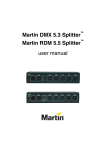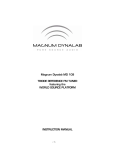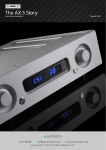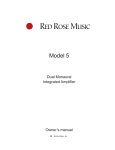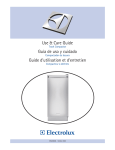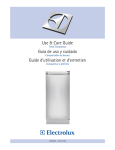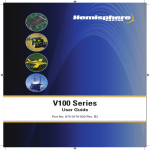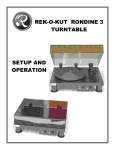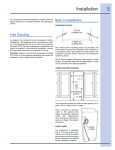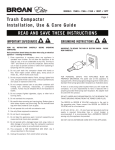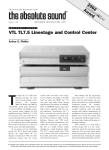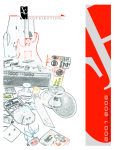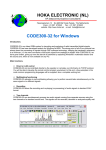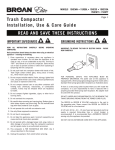Download SMc Audio VRE-1 User's Manual
Transcript
Using your VRE-1 Preamplifier Congratulations on your purchase of the VRE-1 preamplifier. The VRE-1 is simple to setup and operate, but that simplicity belies an exceptionally sophisticated design that includes a great deal of innovative thinking and the best parts available today. Although reading this manual may not be necessary for you to begin enjoying your VRE-1, I urge you to take a few minutes to familiarize yourself with the more novel aspects of its design. Package contents: • • • • • • the VRE-1 preamp its companion power supply 1 analog power link cable by Stealth Audio Cables 1 utility power link cable a polishing cloth owner’s manual Unpacking your VRE-1: Your VRE-1’s box and packing have been carefully designed to protect it during shipping. Please keep all packing materials - these may be important should you ever need to store or ship your preamp again. Both the VRE-1 and its power supply are placed in bags to protect their finish during shipping. The power supply is finished in durable “powder coat” - a tough, scratch-resistant finish. This may be cleaned with any sort of spray cleaner and a paper towel, etc. The VRE-1 is built of Corian (a registered trademark of the DuPont corporation - see www.Corian.com for more information) - a “solidsurface” material often used in home construction. Corian is a very tough, stonelike material that can withstand a lot of abuse, but the high polish on the VRE-1 chassis does require some care to maintain. Please use the polishing cloth included for light cleaning, and avoid paper towels (which are slightly abrasive) that may dull the finish over time. Any cleaning or polishing product suitable for acrylic (or for Corian specifically) may be used, but good old Pledge works very well for general maintenance. If cleaning is required first, a glass cleaner like Windex and a soft rag should do the trick, followed by a shot of Pledge and the polishing cloth. Clean the polishing cloth with your regular laundry as needed. 1 Preparing for use - locating your VRE-1: Your VRE-1 has a lot of wonderful attributes, and one of them is the fact that neither it nor its power supply produce appreciable heat. In addition, the Corian chassis is fairly immune to heat, so the VRE-1 may be installed in an enclosed cabinet. This means that you may locate your VRE-1 and its power supply pretty much wherever you wish, although I recommend that you keep the VRE-1 at least one foot from any piece of equipment that includes a transformer (including its own power supply). This will minimize the possibility of picking-up any hum or radiated noise. The power supply must be kept within the reach of its power link cables (5 feet, or about 1.5M) but may be located at any angle as you deem useful. Refer to the addendum at the end of this manual for more information about the sonic effects of equipment racks and isolation bases. Situate your VRE-1 and power supply, then attach the supplied power link cables. Their connectors prevent you from making a mistake in alignment - they will only mate one way. Both are locking. Align the key of the utility power link cable with its mating connector (Power 2), press it in fully, and screw-down the locking collar (do not over-tighten). The analog power link by Stealth (Power 1) uses a special locking connection made by Neutrik. With the release tab in the up position, line the connectors up and rotate the cable end slightly counterclockwise until it slides in. Press it in fully and rotate the cable end clockwise until you hear the locking “click.” To disconnect, slide the locking tab back and rotate the cable end counter-clockwise until it stops, and then pull it out. Make sure the volume control is down (fully counter-clockwise) and the Mute switch is also down (muted). Then plug-in the AC power cord. Your VRE-1 is now on and ready for use. (Note: If you do not see the LEDs light on both the power supply and VRE-1, please refer to the troubleshooting section at the end of this manual.) There is no power switch because your VRE-1 is designed to stay on continuously. Simply unplug the AC cord if you need to turn your preamp off (engage Mute first). Please Note: The VRE-1’s design includes a variety of practical safety features, including a robust Mute and power system. You may connect or disconnect the power cables in any sequence, even while the power supply is “live” (always be sure that Mute is engaged). Both power link cables are required for operation, but nothing bad will happen if only one is connected, since the VRE-1 simply won’t work. So long as the VRE-1 is muted (Mute switch down), you won’t hear anything from it. The Mute is designed as a true “brick wall.” When it is engaged, nothing will escape the preamp (mute is engaged by default when the power is off). Finally, even if the power goes off or on unexpectedly while the VRE-1 is unmuted, you should hear little or nothing in the way of pops or thumps. 2 Front Panel layout • Input selector switch: Rotary switch selects one of 4 inputs. • Polarity switch and LED indicator: Sets system polarity (absolute polarity, sometimes called “absolute phase”). Up is normal, non-inverted polarity, and flipping the switch down inverts signal polarity. The LED then lights to indicate that system polarity is inverted. Polarity switching is done at the user’s discretion and “correct” system polarity is determined by ear. • Power LED: Indicates that system power is present. • Mute switch and LED indicator: Switch up for listen; down for mute. The LED will light to indicate that mute is engaged. • Volume control: Set system volume with this precision 24-step attenuator. Note: in order to extend the useful range of this control, turning the control fully counter-clockwise (all the way down) does not turn the sound fully off. Engage the Mute switch for system silence. ------------------------------- 3 Front Panel layout • Input selector switch: Rotary switch selects one of 4 inputs. • Polarity switch and LED indicator: Sets system polarity (absolute polarity, sometimes called “absolute phase”). Up is normal, non-inverted polarity, and flipping the switch down inverts signal polarity. The LED then lights to indicate that system polarity is inverted. Polarity switching is done at the user’s discretion and “correct” system polarity is determined by ear. • Power LED: Indicates that system power is present. • Mute switch and LED indicator: Switch up for listen; down for mute. The LED will light to indicate that mute is engaged. • Volume control: Set system volume with this precision stepped attenuator. Note: in order to extend the useful range of this control, turning the control fully counter-clockwise (all the way down) does not turn the sound fully off. Engage the Mute switch for system silence. ------------------------------- Rear Panel layout • Power connections 1 & 2: Power 1 is the analog DC supply via the Neutrik connector, while Power 2 supplies DC power to the relays, lights and Monitor Out buffer. • Main Outputs: The XLR jacks provide balanced output via the Jensen transformers, while the unbalanced RCA connections are direct-coupled to the JFET buffer amplifiers. • Output Ground Switch: Normally left in “float” position. This switch connects the outer electrode of the RCA jacks to either circuit ground (“ground”) or leaves them unconnected (“float”). In some systems grounding the outer RCA contact may be required to eliminate noise. • Monitor Out: Essentially the same as the “Tape Out” of the past, this provides a buffer-isolated signal from the selected input. This output is not controlled by the volume knob, and is useful for feeding a separate system like a dedicated headphone amplifier. • Monitor Out Defeat Switch: In the interest of maximum purity of the main signal path, the Monitor Out buffer may be switched off (defeated) if it is not being used. Just switch this on or off as needed. 4 • Circuit Ground Connector: This binding post offers access to the system electrical ground if needed. There is normally no connection to this post. • Main Input Group: 4 pairs of inputs are provided, labeled 1 thru 4 (corresponding to the front panel Input Selector switch). Input 1 is a dedicated balanced input with XLR connectors, while 2 thru 4 are via RCA unbalanced connectors. I feel that this will be the most useful arrangement for most users since it is still rare for someone to have more than 1 balanced source piece. However, the fact is that all of the inputs are actually balanced - all connections go directly to the input transformers via “floating” (ungrounded) lines. If you happen to have more than one balanced source, custom XLR-to-RCA adapters are available to convert inputs 2 thru 4 to fully-balanced operation. VRE-1 Design Highlights Your VRE-1 is the product of many years of careful research into all aspects of preamplifier behavior - circuit topology, parts performance, physical layout, chassis materials, and power supply design. After many years in the audio field dealing with equipment that colors or changes sound, I wanted to develop a preamplifier that would impose no character of its own, acting as a transparent window onto the original music and recording. We’ve all heard that claim before…the old “straight wire with gain” once again. Well…yes! That’s correct. However, unlike past attempts sometimes characterized as “cold” and “analytical,” my development work has been guided by an unwavering commitment to deliver the warmth and soul of music as it is recorded and heard in live circumstances. What I’ve achieved is a synthesis of the best attributes of passive circuits (tonal neutrality, natural harmonic texture, freedom from noise and active-circuit distortion) with the best characteristics of active preamps (great dynamics, vivid clarity, wide-open dimensionality, outstanding bass foundation and slam) as well as the relaxed musicality of the best tube designs. Let’s address the issue of tubes for a moment. I have experimented extensively with tubes, both in the preamp circuitry and in the power supply. In my experience, tubes simply cannot deliver the degree of tonal neutrality that I demanded for the VRE-1. My goal was not to make yet another “good sounding” preamp, but rather to deliver an absolutely transparent window onto the original recording or master tape. My listening tests led me to an exceptionally transparent JFET buffer circuit with no gain which, when paired with my choke-filtered power supply, produces unparalleled overall performance. When I found the right set of coupling transformers (Lundahl on the input; Jensen on the output), the last pieces of the puzzle fell into place and the VRE-1 was born. Its transformers act as a kind of 5 near-ideal load on the input and confer that magic tube-like musicality. They also act as a “brick wall” filter against DC and RFI contamination. In addition, they allow the VRE-1 to be configured for voltage gain (up to +6dB) if it is needed. Thus, the VRE-1 is a “passive” preamp -- but with gain. Finally, all of the parts and materials used to build your VRE-1 are the best available. A partial list includes parts from Lundahl Transformers, Jensen Transformers, Avel-Lindberg, Shallco Switch, Black Gate, Audio Note, Vishay, Van den Hul, Shunyata, Wonder Wire & solder, WBT, Neutrik, EAR Specialty Composites, Vibrapod, and DuPont Corian. Your VRE-1 delivers the following performance attributes: • Perfectly coherent clarity: seamless character top-to-bottom, with no region emphasized or depreciated, with no sonic vagueness, muddiness, smearing, or veil. • Top-to-bottom transparency: that “see-through” quality that gives you the feeling of looking across the space and venue of the original recording. • Effortless dynamic expression: from the quietest passages to the loudest, the VRE-1 portrays music’s full dynamic power and subtlety -from the thunderous strike of a drum to the nearly subliminal shift in a singer’s breath. • Pinpoint focus and localization of instruments and voices within a 3-D sound field – exquisitely clear individualization of musical lines. • Deep emotional connection with the music: perhaps the most elusive and important quality of all. • The ability to achieve all of the above at any volume level. • Elegant simplicity of design with intuitive control operation. • A beautiful, non-resonant chassis (solid-surface-technology) which makes an important contribution to its stunning performance. • Safe, reliable, low–voltage operation generates practically no heat. • Absolute reliability and stability of performance over time. The VRE-1 will always ready to deliver beautiful music, whether it is new or many years old. 6 The Power Supply The VRE-1’s companion power supply provides carefully tailored DC power for the proper operation of your preamp. The “Power 1” connection provides +/- 24 VDC of choke-filtered, unregulated power, while the “Power 2” connection provides +/- 24 VDC of fully regulated power for the relays, LEDs, and Monitor Out buffer amplifier. Power supply design is critical to superior performance. In a very real sense, it is the power supply we are hearing when we listen to music. One of the keys to the VRE-1’s superiority is that its JFET buffer circuitry does not require a regulated supply, so this source of signal degradation was eliminated. Voltage regulators are very much like amplifiers, and all of the same rules of sound quality apply to them. Eliminating this regulator stage allows the VRE-1 to get that much closer to being a true “window on the performance.” The VRE-1 supply uses the finest quality parts I have found through careful study and experimentation: a superb toroidal power transformer, soft-recovery diodes, outstanding chokes from Lundahl, superior capacitors, resistors, and wire, and selected damping feet. The critical analog power-link cable is custom-made for the VRE-1 by Stealth Audio Cables, and uses their proprietary molybdenum carbon conductor technology. This was chosen after lengthy listening evaluations with a wide variety of cable options. Even the AC inlet is chosen for superior clarity and transparency. Each power supply is “voiced” by ear before delivery, which involves listening to the various permutations of transformer secondary wiring. Its design and construction is an exercise in total “overkill” - its current capability vastly exceeds the requirements of the VRE-1, but I feel this translates into superior performance and reliability. Literally, only the best will do. Chassis and Feet Every aspect of an audiophile component’s design affects its performance to one degree or another, and this is true of chassis materials as well. I discovered long ago that different metals (aluminum, steel, stainless-steel, copper, brass, etc.) produced different sonic results with a given circuit, and this led to my use of aluminum and copper-plated steel as preferred chassis materials. However, various experiments I did in the course of developing new designs began to suggest that eliminating metal altogether might produce even better results. This led to experiments with Nylon, Delrin, different types of wood, and finally to solidsurface synthetic materials. These materials are more difficult to work with than traditional metals, but I consider the results to well worth the effort. The VRE-1’s chassis is much more inert mechanically than traditional designs, and the elimination of metal does away with certain colorations that get in the way of true transparency. 7 Please Note: The VRE-1 is a hand-built work of “industrial art.” It is a beautiful object, and a great deal of effort has gone into its creation. Ironically, because it is hand-made, you may find small blemishes that do not occur in the routine perfection of mass-marketed consumer goods. We believe you’ll accept these as part of the unique personality of your VRE-1. Your VRE-1 comes with a set of high-quality damping feet from Vibrapod. However, you may wish to experiment with other types of feet, including hard points. Any change in the feet will affect sonic performance, and it is up to you to decide if the change is worthwhile. The best accessory feet I have experience with are the Apex feet from Grand Prix Audio (see www.GrandPrixAudio.com for more information). CAUTION: Vibrapod Isolators may blemish certain finishes. Use drink coasters, playing cards, or other thin pieces of paper or plastic under them to protect your fine furniture. Interconnect Cables The subject of interconnect cables is important because they can have a profound impact on your system’s performance. Your VRE-1 has been designed to be compatible with all types of cables, but choosing the right set of cables can enhance your sense of involvement and your listening pleasure. Unfortunately, there is no way to predict which cables will work best for you, and the fact that I use a particular brand is no guarantee that they will work as well in your system. You must evaluate cables by listening to them in your own system, and you must not allow yourself to be overly swayed by reviews and other opinions. Trust your own ears and your own judgement. Break-in Period The notion that audio equipment changes how it sounds or “breaks-in” over time is controversial in some circles (much like everything in audio), but it is very real to me. It seems clear to me that new pieces of equipment undergo a process of change that may take a few days, or even a few weeks to complete. The exact reasons why are endlessly arguable, but include electrical, thermal, chemical, mechanical, and psychological effects. Honestly, I am not interested in debating the reasons why, but I do want to make you aware of the process. The break-in phenomenon has become more of an issue in recent years because the latest high-performance parts seem to take longer to fully break-in. Some newer parts (like carbon wire) take little or no time to sound their best, but the great majority of new parts I have discovered take quite a while to fully reveal themselves. A few parts, like the Lundahl amorphous-core transformers, take an unusually long time - up to several weeks. 8 This is important because I cannot fully break-in your VRE-1 before shipping. Your preamp has been thoroughly tested and listened-to, but this is just the beginning. I make every effort to present you with a good initial impression, but beyond that it is up to you to complete the break-in process, and to *understand* that it will take time. Break-in is a process of using your equipment - not simply leaving it turned on. You must have something playing (music or some sort of break-in signal) to get the job done. I feel that playing music normally works perfectly well, but there are special CDs and LPs made as “break-in discs” that are favored by some. Check with your audio dealer or music supplier if you are interested in these. The main thing is to understand that it will take some time for your VRE-1 to realize its full potential, and I urge you to relax and enjoy listening to music while it breaks-in, warms-up, settles-down, or whatever you want to call it. Specifications (as usual, subject to change) VRE-1 PREAMP Gain (factory adjustable) --------Bandwidth -------------------------Output impedance -----------Output impedance -----------Power consumption -------AC Mains fuse -------------------Dimensions ------------------------Weight ---------------------------------- -6dB, 0 dB, or +6dB (typically set at 0dB unity gain) +/- 3dB <5Hz - 170KHz balanced out: 250 Ohms unbalanced out: 50 Ohms 10W T1A @ 115VAC / T.5A @ 230VAC 17.5”W x 12.75”D x 5”H (includes hardware & feet) 25 lbs VRE-1 POWER SUPPLY Dimensions-------------------------- 10.25”W x 9.5”D x 3.625”H Weight ---------------------------------- 11 lbs Total Shipping Weight - Approximately 42 lbs Troubleshooting Problem: No sound, no lights, no nothing. Solution: Check your AC power connection to the wall outlet to make sure you are getting power; check the AC Mains fuse to see if it is blown - replace if necessary. Problem: You have lights and hear the relays click, but no sound. Solution: Your analog power link cable may not be connected properly - check for proper cable connection. Check the obvious - is your amp turned on? Correct input selected? Source playing? Check the interconnect cables to and from your VRE-1. Be sure you have selected a working input. 9 Acknowledgements This project has been in development for a long time, and I sincerely thank everyone who contributed in any way to its success. However, there are a few people I would like to point-out for their special contributions… • Jim Merod - For his to-the-point observations and criticism, and his indefatigable efforts on behalf of music, musicians, and the audio community. • Kris Jeter - His hard work keeps the wheels turning here at SMc Audio, and his good humor makes the work go smoothly. • Carl and Lena Carpenter / Carpenter’s Fine Woodworking - Their precision machining work on the original wooden prototypes and subsequent Corian models made this project a reality. • Jerry Boncer - For all of his help in the past, and for his original design of the JFET buffer circuit that made its way into the VRE-1. • Conrad Lindberg - For all of his help with circuit development and board layout, and numerous practical suggestions. • Lundahl Transformers - For their enthusiastic support and useful technical insights. 929 El Pajodo Place Vista, CA 92084 Tel: 760-732-0352 [email protected] / www.SMcAudio.com 10 Getting the most from your VRE-1 preamplifier - a user’s guide Suggestions for AC cords and accessories After some thought, I have come to the decision to leave a “standard” AC cord out of the parts complement. It is my experience that the AC cord is an integral part of the sound of your VRE-1, and I suggest that you use the best power cord you can find. Your VRE-1’s amplification circuitry may be thought of as a sort of valve that modulates the power supply, and it is the quality of the power supply that you actually hear. I have spent a great deal of time and effort in developing the VRE-1 and its power supply, and I have examined every detail - right down to the fuse. A great aftermarket AC cord is a must for getting the best-possible performance, but I have chosen to not include an aftermarket cord for several reasons, including matters of personal taste, system synergy, and cost. My own experience includes cords from Kubala-Sosna (the “Emotion”), Acoustic Zen (the “Gargantua”), AudioPrism (the “Super Natural S-2”), Magnan Audio (the “Signature Power Cable’), and Shunyata Research (the “Anaconda”) to name a few. These are all excellent cords, but each has its own personality and may or may not work well in your system. Please take some time to do your own evaluation and you will be rewarded with the best-possible performance from your VRE-1. Beyond the power cord (and, obviously, your interconnect cable choices) there are matters of chassis damping and isolation to consider. Your VRE-1’s Corian chassis is quite inert on its own, and I have fitted both it and the power supply with excellent damping feet. Still, the fact remains that your choice of stand and/or accessory feet will affect performance. In my own system, I have chosen isolation stand systems by Grand Prix Audio (the “Monaco” series) and their outstanding “Formula” carbon composite shelves (their “Apex” feet are also outstanding). My experience suggests strongly that you will not hear everything your VRE-1 (and your other equipment) has to offer unless you use an isolation stand system of similar quality. Your choices may differ, but please give some thought to this part of your system and its sonic effect. The Corian chassis is both heavy and inert, but you may still wish to experiment with added weight. Some piece of concentrated mass about the size of a book, for instance - like a piece of marble, granite, or similar stone - may provide a noticeable sonic benefit. Be sure to protect the Corian with some soft material. I have also found that I like the effect of using a Shakti Electromagnetic Stabilizer (aka the Shakti “Stone”) on top of the power supply. The effect is subtle, but I feel it contributes to the overall smoothness and liquidity that I enjoy. If, while enjoying your VRE-1 you find some beneficial accessory or “tweak,” please let me know. I would appreciate hearing about your experience. 11 Grounding Options Your VRE-1 provides several options for matching earth ground arrangements for best results with your system. A binding post connected to circuit ground is provided on the rear panel to facilitate external connections to other equipment chassis grounds if need be, and an adjustable ground jumper is provided inside the power supply. This jumper provides 3 options for the connection between earth ground and circuit ground: A) isolated connection via an RC network consisting of a 100 Ohm resistor in parallel with a .01uF capacitor, B) direct (zero-ohm) connection, and C) no connection. (Please note that the use of a 3wire grounded AC cord assumes that an appropriate earth ground connection is provided by your house AC wiring.) The VRE-1 is shipped with this ground jumper set in the (A) isolated position. This seems to work well in most circumstances, but you should experiment with the jumper setting if you are experiencing any hum and/or buzz issues. Locate the jumper by unplugging your power supply first for safety, then removing the top 2 screws on either side of the cover (4 screws total). Remove the cover by lifting it straight up. The ground jumper is located near the front edge of the main circuit board, near the LED wire (see the photo below). Change the jumper position by pulling it straight up (use your fingers or some small pliers) and moving it to the alternate setting. The header has 3 pins, and the jumper covers 2 at a time (the center pin is always used). The left side (as seen in the photo) is position “A” and the right side is position “B”. The jumper may be removed completely for setting “C” (no connection). Note: You will see several other jumpers in the power supply, but do NOT move them. These are factory-set for proper operation of your VRE-1. 12 Tuning the Stealth power link cable Your VRE-1 uses a custom-built power-link cable from Stealth Audio Cables. This cable includes a carbon-composite sleeve that will slide along its length. The position of this sleeve has a “tuning” effect - moving it will affect the sound of your preamp to some degree. I find the effect to be significant enough to bring it to your attention. You may or may not find it meaningful in your system, but I suggest that it is worth investigating. In my listening tests I have found that a “golden ratio” tuning adjustment seems to work well. The overall cable length is around 62” (157.5cm), and this places the sleeve at about 24” (61cm) from one end (see photo below). As always, I encourage you to experiment. I have also found that turning the cable around (exchanging the ends) made some difference in the sound - a bit more “laid back” in one direction, and a bit more dynamically lively in the other. There is no explanation for this - the cable design is completely symmetrical (you are also free to call me crazy if you wish ;-) Have fun, and enjoy your music. 13 Using the XLR-to-RCA balanced input adaptors As stated in the owner’s manual, all 4 of the VRE-1’s inputs are actually balanced. I chose the connector arrangement based on a best-guess estimate of what most audiophiles are likely to have in their systems - one balanced source (XLR), and the rest unbalanced (RCA). If you have more than one balanced source and wish to take full advantage of its balanced mode of operation, I can provide custom-built adaptors to allow for this. Here is a photo of what they look like in operation: photo by Frederic Beudot for 6Moons.com I build these adaptors from premium parts to be as sonically transparent as possible, and they work exceptionally well. If you prefer, you can build them yourself. I choose silver-plated Neutrik XLR cable-mount female connectors, WBT Next-Gen silver cablemount RCAs (#0110AG), and I use Wonder Wire for the connections. A separate 22ga, Teflon-insulated wire is used for the XLR pin 1 connection to chassis ground, and I terminate it with a stacking-type banana plug to facilitate the use of multiple adaptors. Connect the wires as follows (note that these are NOT typical XLR-RCA adaptors): XLR pin 1 - flying lead to stacking banana plug (shield ground) XLR pin 2 - to RCA center pin (plus hot) XLR pin 3 - to RCA outer case (negative hot) You can add whatever number you need, including converting all inputs to full-balanced operation if that is what your system requires. Steve McCormack, designer - SMc Audio 14















